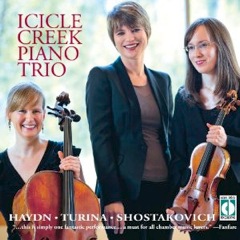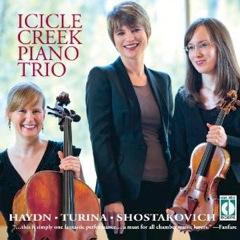
The Icicle Creek Piano Trio — Oksana Ezhokina (piano), Jennifer Caine (violin), and Sally Singer (cello) — is an ensemble new to me, but one I’ll be following closely in future. Its new disc on the Con Brio label, of Haydn, Turina, and Shostakovich (its second CD), reveals an ensemble that can cover a lot of stylistic ground without missing a beat.
I admit to being slightly disappointed in the Haydn. This trio (in E major, Hob. XV:28) is one of the more eccentric works in a genre where Haydn gave his imagination even freer rein than he did elsewhere, and the Icicle Creek players regularize it a bit too much for my taste. The slow movement — a passacaglia, most of which is solo piano, the right hand wandering octaves over a sepulchral bass line — sounds altogether too healthy and sane here. And there is more fun to be gotten out of the finale than this trio finds.
I admire, though, the players’ attentiveness to balance and texture. The first movement’s opening — little rolled grace notes in the piano, pizzicato in the strings — is the kind of thing that’s a lot easier to bring off with a fortepiano and gut strings; here it sounds as natural as I’ve ever heard it on modern instruments. And Singer, a constant and unfailingly attentive presence, doesn’t mistake her role for that of an equal partner in what is really a piano-plus-violin-plus-bass-reinforcement situation.
Listen To The Music
Haydn Piano Trio in E: Allegro moderatoPurchase Recording


A portion of each purchase helps
support San Francisco Classical Voice
That Singer’s reticence in the Haydn is discretion (rather than lack of power) we find out rapidly in the rest of the program. Joaquín Turina’s 1942 Circulo, the last of his four piano trios, is one of those pieces you find yourself wondering why you haven’t heard before, so immediately attractive is the music. The reasons, I’d guess, are partly Turina’s relative obscurity and partly plain logistics: Where on a program do you put a 10-minute trio?
The piece is in three brief movements, depicting dawn, midday, and dusk. Turina is evidently most Spanish in direct sunlight; at early morning and twilight, he might almost be mistaken for Ravel. The opening movement’s expansion toward sunlit glory is an amazing thing to be packed into four minutes, and the sunset is also glorious, not Technicolor but superbly muted.
As for the Shostakovich Op. 67 Trio that takes up the balance of the disc, I suppose I’ve heard it played as well, but not often. Caine and Singer are in eerie accord all the time, matching timbres and dynamics with what appears almost casual perfection. Singer’s opening harmonics are inhumanly clean and pure. Ezhokina is simply magnificent everywhere; you get the impression that she can put out any amount of power and still maintain perfect clarity.
The performance’s flaw is that sometimes it doesn’t seem hard enough work. It’s not natural to sail through the Shostakovich’s brutal F-sharp-major scherzo so elegantly; the thing’s obviously designed purposefully to sound ugly, and in all its early recordings, it does. There is, alas, such a thing as doing stuff too well.

